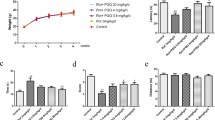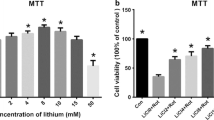Abstract
In addition to its original application for treating tuberculosis, rifampicin has multiple potential neuroprotective effects in chronic neurodegenerative diseases including Parkinson’s disease (PD) and Alzheimer’s disease. Inflammatory reactions and the PI3K/Akt pathway are strongly implicated in dopaminergic neuronal death in PD. This study aims to investigate whether rifampicin protects rotenone-lesioned SH-SY5Y cells via regulating PI3K/Akt/GSK-3β/CREB pathway. Rotenone-treated SH-SY5Y cells were used as the cell model to investigate the neuroprotective effects of rifampicin. Cell viability and apoptosis of SH-SY5Y cells were determined by CCK-8 assay and flow cytometry, respectively. The expression of Akt, p-Akt, GSK-3β, p-GSK-3β, CREB and p-CREB were measured by Western blot. Our results showed that the cell viability and level of phospho-CREB significantly decreased in SH-SY5Y cells exposed to rotenone when compared to the control group. Both the cell viability and the expression of phospho-CREB in cells pretreated with rifampicin were higher than those of cells exposed to rotenone alone. Moreover, pretreatment of SH-SY5Y cells with rifampicin enhanced phosphorylation of Akt and suppressed activity of GSK-3β. The addition of LY294002, a PI3K inhibitor, could suppress phosphorylation of Akt and CREB and activate GSK-3β, resulting in abolishment of neuroprotective effects of rifampicin on cells exposed to rotenone. Rifampicin provides neuroprotection against dopaminergic degeneration, partially via the PI3K/Akt/GSK-3β/CREB signaling pathway. These findings suggest that rifampicin could be an effective and promising neuroprotective candidate for treating PD.




Similar content being viewed by others
References
Masliah E, Rockenstein E, Veinbergs I, Mallory M, Hashimoto M, Takeda A, Sagara Y, Sisk A, Mucke L (2000) Dopaminergic loss and inclusion body formation in alpha-synuclein mice: implications for neurodegenerative disorders. Science 287:1265–1269
Kilic U, Kilic E, Lingor P, Yulug B, Bahr M (2004) Rifampicin inhibits neurodegeneration in the optic nerve transection model in vivo and after 1-methyl-4-phenylpyridinium intoxication in vitro. Acta Neuropathol 108:65–68
Xu J, Wei C, Xu C, Bennett MC, Zhang G, Li F, Tao E (2007) Rifampicin protects PC12 cells against MPP+-induced apoptosis and inhibits the expression of an alpha-Synuclein multimer. Brain Res 1139:220–225
Liang Y, Jing X, Zeng Z, Bi W, Chen Y, Wu X, Yang L, Liu J, Xiao S, Liu S, Lin D, Tao E (2015) Rifampicin attenuates rotenone-induced inflammation via suppressing NLRP3 inflammasome activation in microglia. Brain Res 1622:43–50
Jing X, Shi Q, Bi W, Zeng Z, Liang Y, Wu X, Xiao S, Liu J, Yang L, Tao E (2014) Rifampicin protects PC12 cells from rotenone-induced cytotoxicity by activating GRP78 via PERK-eIF2alpha-ATF4 pathway. PLoS ONE 9:e92110
Liang Y, Zhou T, Chen Y, Lin D, Jing X, Peng S, Zheng D, Zeng Z, Lei M, Wu X, Huang K, Yang L, Xiao S, Liu J, Tao E (2017) Rifampicin inhibits rotenone-induced microglial inflammation via enhancement of autophagy. Neurotoxicology 63:137–145
Mori N, Fujii M, Cheng G, Ikeda S, Yamasaki Y, Yamada Y, Tomonaga M, Yamamoto N (2001) Human T-cell leukemia virus type I tax protein induces the expression of anti-apoptotic gene Bcl-xL in human T-cells through nuclear factor-kappaB and c-AMP responsive element binding protein pathways. Virus Genes 22:279–287
Wilson BE, Mochon E, Boxer LM (1996) Induction of bcl-2 expression by phosphorylated CREB proteins during B-cell activation and rescue from apoptosis. Mol Cell Biol 16:5546–5556
Sun H, Wu H, Liu J, Wen J, Zhu Z, Li H (2017) Prenatal Stress Impairs Spatial Learning and Memory Associated with Lower mRNA Level of the CAMKII and CREB in the Adult Female Rat Hippocampus. Neurochem Res 42:1496–1503
Nakaso K, Tajima N, Horikoshi Y, Nakasone M, Hanaki T, Kamizaki K, Matsura T (2014) The estrogen receptor beta-PI3K/Akt pathway mediates the cytoprotective effects of tocotrienol in a cellular Parkinson’s disease model. Biochimica et Biophys Acta 1842:1303–1312
Teng L, Meng Q, Lu J, Xie J, Wang Z, Liu Y, Wang D (2014) Liquiritin modulates ERK and AKT/GSK3betadependent pathways to protect against glutamateinduced cell damage in differentiated PC12 cells. Mol Med Rep 10:818–824
Kwon SH, Ma SX, Lee SY, Jang CG (2014) Sulfuretin inhibits 6-hydroxydopamine-induced neuronal cell death via reactive oxygen species-dependent mechanisms in human neuroblastoma SH-SY5Y cells. Neurochem Int 74:53–64
Han X, Lan X, Li Q, Gao Y, Zhu W, Cheng T, Maruyama T, Wang J (2016) Inhibition of prostaglandin E2 receptor EP3 mitigates thrombin-induced brain injury. J Cereb Blood Flow Metab 36:1059–1074
Pringsheim T, Jette N, Frolkis A, Steeves TD (2014) The prevalence of Parkinson’s disease: a systematic review and meta-analysis. Mov Disord 29:1583–1590
Elbaz A, Clavel J, Rathouz PJ, Moisan F, Galanaud JP, Delemotte B, Alperovitch A, Tzourio C (2009) Professional exposure to pesticides and Parkinson disease. Ann Neurol 66:494–504
Hernandez DG, Reed X, Singleton AB (2016) Genetics in Parkinson disease: Mendelian versus non-Mendelian inheritance. J Neurochem 139(Suppl 1):59–74
Ramkumar M, Rajasankar S, Gobi VV, Dhanalakshmi C, Manivasagam T, Justin Thenmozhi A, Essa MM, Kalandar A, Chidambaram R (2017) Neuroprotective effect of Demethoxycurcumin, a natural derivative of Curcumin on rotenone induced neurotoxicity in SH-SY 5Y Neuroblastoma cells. BMC Complement Altern Med 17:217
Lin D, Jing X, Chen Y, Liang Y, Lei M, Peng S, Zhou T, Zheng D, Zeng Z, Wu X, Yang L, Xiao S, Liu J, Tao E (2017) Rifampicin pre-treatment inhibits the toxicity of rotenone-induced PC12 cells by enhancing sumoylation modification of alpha-synuclein. Biochem Biophys Res Commun 485:23–29
Anusha C, Sumathi T, Joseph LD (2017) Protective role of apigenin on rotenone induced rat model of Parkinson’s disease: Suppression of neuroinflammation and oxidative stress mediated apoptosis. Chem Biol Interact 269:67–79
Walton MR, Dragunow I (2000) Is CREB a key to neuronal survival? Trends Neurosci 23:48–53
Lin R, Lin Y, Tao J, Chen B, Yu K, Chen J, Li X, Chen LD (2015) Electroacupuncture ameliorates learning and memory in rats with cerebral ischemia-reperfusion injury by inhibiting oxidative stress and promoting p-CREB expression in the hippocampus. Mol Med Rep 12:6807–6814
Ge L, Liu L, Liu H, Liu S, Xue H, Wang X, Yuan L, Wang Z, Liu D (2015) Resveratrol abrogates lipopolysaccharide-induced depressive-like behavior, neuroinflammatory response, and CREB/BDNF signaling in mice. Eur J Pharmacol 768:49–57
Credle JJ, George JL, Wills J, Duka V, Shah K, Lee YC, Rodriguez O, Simkins T, Winter M, Moechars D, Steckler T, Goudreau J, Finkelstein DI, Sidhu A (2015) GSK-3beta dysregulation contributes to parkinson’s-like pathophysiology with associated region-specific phosphorylation and accumulation of tau and alpha-synuclein. Cell Death Differ 22:838–851
Linseman DA, Butts BD, Precht TA, Phelps RA, Le SS, Laessig TA, Bouchard RJ, Florez-McClure ML, Heidenreich KA (2004) Glycogen synthase kinase-3beta phosphorylates Bax and promotes its mitochondrial localization during neuronal apoptosis. J Neurosci 24:9993–10002
Zhang L, Zhang Y, Xing D (2010) LPLI inhibits apoptosis upstream of Bax translocation via a GSK-3beta-inactivation mechanism. J Cell Physiol 224:218–228
Li L, Klebe D, Doycheva D, McBride DW, Krafft PR, Flores J, Zhou C, Zhang JH, Tang J (2015) G-CSF ameliorates neuronal apoptosis through GSK-3beta inhibition in neonatal hypoxia-ischemia in rats. Exp Neurol 263:141–149
Ahn SW, Kim JE, Park KS, Choi WJ, Hong YH, Kim SM, Kim SH, Lee KW, Sung JJ (2012) The neuroprotective effect of the GSK-3beta inhibitor and influence on the extrinsic apoptosis in the ALS transgenic mice. J Neurol Sci 320:1–5
Bian H, Bian W, Lin X, Ma Z, Chen W, Pu Y (2016) RNA Interference Silencing of Glycogen Synthase Kinase 3beta Inhibites Tau Phosphorylation in Mice with Alzheimer Disease. Neurochem Res 41:2470–2480
Wang Y, Yang R, Gu J, Yin X, Jin N, Xie S, Wang Y, Chang H, Qian W, Shi J, Iqbal K, Gong CX, Cheng C, Liu F (2015) Cross talk between PI3K-AKT-GSK-3beta and PP2A pathways determines tau hyperphosphorylation. Neurobiol Aging 36:188–200
Kim DE, Kim B, Shin HS, Kwon HJ, Park ES (2014) The protective effect of hispidin against hydrogen peroxide-induced apoptosis in H9c2 cardiomyoblast cells through Akt/GSK-3beta and ERK1/2 signaling pathway. Exp Cell Res 327:264–275
Gong L, Zhang QL, Zhang N, Hua WY, Huang YX, Di PW, Huang T, Xu XS, Liu CF, Hu LF, Luo WF (2012) Neuroprotection by urate on 6-OHDA-lesioned rat model of Parkinson’s disease: linking to Akt/GSK3beta signaling pathway. J Neurochem 123:876–885
Yuan YH, Yan WF, Sun JD, Huang JY, Mu Z, Chen NH (2015) The molecular mechanism of rotenone-induced alpha-synuclein aggregation: emphasizing the role of the calcium/GSK3beta pathway. Toxicol Lett 233:163–171
Wu Y, Shang Y, Sun S, Liang H, Liu R (2007) Erythropoietin prevents PC12 cells from 1-methyl-4-phenylpyridinium ion-induced apoptosis via the Akt/GSK-3beta/caspase-3 mediated signaling pathway. Apoptosis 12:1365–1375
Song JX, Shaw PC, Wong NS, Sze CW, Yao XS, Tang CW, Tong Y, Zhang YB (2012) Chrysotoxine, a novel bibenzyl compound selectively antagonizes MPP(+), but not rotenone, neurotoxicity in dopaminergic SH-SY5Y cells. Neurosci Lett 521:76–81
Jain V, Baitharu I, Prasad D, Ilavazhagan G (2013) Enriched environment prevents hypobaric hypoxia induced memory impairment and neurodegeneration: role of BDNF/PI3K/GSK3beta pathway coupled with CREB activation. PLoS ONE 8:e62235
Acknowledgements
This work was supported by grants from the National Natural Science Foundation of China (Grant Numbers 81571244, 81771378, 81371391 and 81503052), the Public Welfare Research and Capacity Building Project of Guangdong Province (Grant Number 2014A020212164), the Natural Science Foundation of Guangdong Province (Grant Numbers 2014A030313202, 2016A030313322 and 2017A030313840), the Guangzhou Science and Technology Research Project (Grant Number 201607010219), and the Fundamental Research Fund for University Youth Scholars (Grant Number 17ykpy39).
Author information
Authors and Affiliations
Corresponding author
Ethics declarations
Conflict of interest
All authors announce no competing interests.
Informed Consent
For this type of study formal consent is not required.
Research Involving Human and Animal Participants
The article does not contain any studies with human participants or animals performed by any of the authors.
Rights and permissions
About this article
Cite this article
Wu, X., Liang, Y., Jing, X. et al. Rifampicin Prevents SH-SY5Y Cells from Rotenone-Induced Apoptosis via the PI3K/Akt/GSK-3β/CREB Signaling Pathway. Neurochem Res 43, 886–893 (2018). https://doi.org/10.1007/s11064-018-2494-y
Received:
Revised:
Accepted:
Published:
Issue Date:
DOI: https://doi.org/10.1007/s11064-018-2494-y




